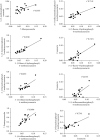Western Diet Decreases Hepatic Drug Metabolism in Male LDLr-/-ApoB100/100 Mice
- PMID: 37034183
- PMCID: PMC10081903
- DOI: 10.1155/2023/5599789
Western Diet Decreases Hepatic Drug Metabolism in Male LDLr-/-ApoB100/100 Mice
Abstract
Consumption of a Western diet is an important risk factor for several chronic diseases including nonalcoholic fatty liver disease (NAFLD), but its effect on the xenobiotic metabolizing enzyme activities in the liver has been studied incompletely. In this study, male LDLr-/-ApoB100/100 mice were fed with Western diet (WD) or a standard diet for five months to reveal the effects on drug metabolism such as cytochrome P450 (CYP) oxidation and conjugation activities in the liver. Hepatic steatosis, lobular inflammation, and early fibrosis were observed in WD fed mice, but not in chow diet control mice. When compared to the controls, the WD-fed mice had significantly decreased protein-normalized CYP probe activities of 7-ethoxyresorufinO-deethylation (52%), coumarin 7-hydroxylation (26%), 7-hydroxylation of 3-(3-fluoro-4-hydroxyphenyl)-6-methoxycoumarin (70%), 7-hydroxylation of 3-(4-trifluoromethoxyphenyl)-6-methoxycoumarin (78%), 7-hydroxylation of 3-(3-methoxyphenyl)coumarin (81%), and pentoxyresorufin O-depentylation (66%). Increased activity was seen significantly in sulfonation of 3-(4-methylphenyl)-7-hydroxycoumarin (289%) and cytosol catechol O-methyltranferase (COMT, 148%) in the WD group when compared to the controls. In conclusion, the WD-induced steatosis in male LDLr-/-ApoB100/100 mice was associated with decreased CYP oxidation reactions but had no clear effects on conjugation reactions of glucuronidation, sulfonation, and cytosolic catechol O-methylation. Consequently, the WD may decrease the metabolic elimination of drugs compared to healthier low-fat diets.
Copyright © 2023 Markus Koponen et al.
Conflict of interest statement
The authors declare that they have no conflicts of interest.
Figures





Similar articles
-
Docosahexaenoic acid blocks progression of western diet-induced nonalcoholic steatohepatitis in obese Ldlr-/- mice.PLoS One. 2017 Apr 19;12(4):e0173376. doi: 10.1371/journal.pone.0173376. eCollection 2017. PLoS One. 2017. PMID: 28422962 Free PMC article.
-
Is Western Diet-Induced Nonalcoholic Steatohepatitis in Ldlr-/- Mice Reversible?PLoS One. 2016 Jan 13;11(1):e0146942. doi: 10.1371/journal.pone.0146942. eCollection 2016. PLoS One. 2016. PMID: 26761430 Free PMC article.
-
The nonalcoholic fatty liver disease-like phenotype and lowered serum VLDL are associated with decreased expression and DNA hypermethylation of hepatic ApoB in male offspring of ApoE deficient mothers fed a with Western diet.J Nutr Biochem. 2020 Mar;77:108319. doi: 10.1016/j.jnutbio.2019.108319. Epub 2019 Dec 19. J Nutr Biochem. 2020. PMID: 31926452
-
A metabolomic analysis of omega-3 fatty acid-mediated attenuation of western diet-induced nonalcoholic steatohepatitis in LDLR-/- mice.PLoS One. 2013 Dec 17;8(12):e83756. doi: 10.1371/journal.pone.0083756. eCollection 2013. PLoS One. 2013. PMID: 24358308 Free PMC article.
-
Restricted feeding for 9h in the active period partially abrogates the detrimental metabolic effects of a Western diet with liquid sugar consumption in mice.Metabolism. 2018 May;82:1-13. doi: 10.1016/j.metabol.2017.12.004. Epub 2017 Dec 16. Metabolism. 2018. PMID: 29253490
References
-
- Brunt E. M. Pathology of fatty liver disease. Modern Pathology . 2007;40 - PubMed
-
- Gonzalez F. J., Coughtrie M., Tukey R. H. Drug metabolism. In: Brunton L. L., Hilal-Dandan R., Knollman B. C., editors. Goodman & Gilmans’s the Pharmacological Basis of Therapeutics . 13. New York: McGraw-Hill; 2018. pp. 85–100.
-
- Parkinson A., Ogilvie B. W., Buckley D. B., Kazmi F., Parkinson O. Casarett & Doull’s Toxicology: The Basic Science of Poisons, Klaassen CD . 9. New York: McGraw-Hill; 2019. Biotransformation of xenobiotics; pp. 193–430.
LinkOut - more resources
Full Text Sources
Miscellaneous

